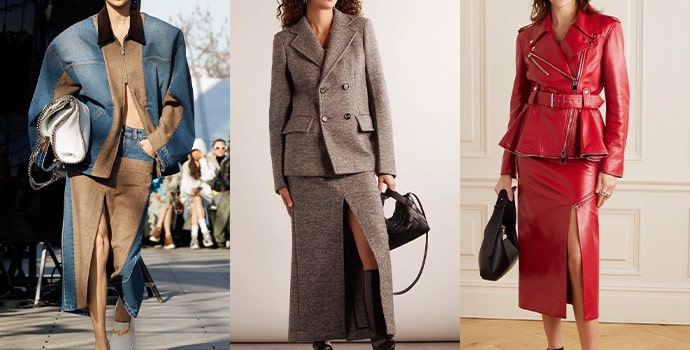The Role of Fabric in Defining Quality in Branded Clothing
The Role of Fabric in Defining Quality in Branded Clothing
Blog Article
Recognizing Clothes: The Importance of Textile Choices in Your Wardrobe
The choice of material in clothes plays a critical role in both visual appeals and capability. Different materials use varying degrees of longevity, comfort, and breathability, directly influencing the user's experience. Comprehending these subtleties can enhance one's closet considerably. Numerous forget exactly how these choices can affect not just individual style, but additionally sustainability. What textile decisions could redefine your wardrobe and straighten it with both design and obligation?
The Duty of Textile in vogue and Capability

Usual Material Types and Their Characteristics
When picking apparel, comprehending the features of usual textile kinds is important for making notified selections. Cotton, a widely-used natural fiber, is known for its softness, convenience, and breathability, making it ideal for laid-back wear and daily garments. Linen, one more natural option, boasts excellent moisture-wicking residential or commercial properties and a distinct structure, suitable for warm climates.Wool, usually favored for its warmth and longevity, differs in fineness; merino woollen is soft versus the skin, while coarser types are utilized for outerwear. Artificial textiles like polyester and nylon use resilience and resistance to creases, making them popular for activewear and traveling garments. Lastly, blends, which integrate synthetic and all-natural fibers, can enhance performance while keeping convenience. By acknowledging these textile attributes, people can select garments that lines up with their way of life and visual choices.
Breathability and Comfort: Selecting the Right Fabrics for Various Environments
Choosing the right fabrics for different environments can greatly enhance comfort and total wearability. Breathable materials are important in warm climates, as they enable air circulation and dampness dissipation. Fabrics such as cotton, linen, and moisture-wicking synthetics efficiently draw sweat away from the body, maintaining the wearer cool and dry. Alternatively, in colder environments, thicker textiles like wool or fleece offer insulation while retaining breathability, ensuring heat without overheating.Additionally, the option of textile weight plays an important function; lightweight textiles are preferable for summertime, whereas much heavier alternatives are matched for winter wear. Comprehending the distinct buildings of each material enables individuals to clothe properly for differing climate condition. Inevitably, selecting breathable and comfortable textiles tailored to certain environments can considerably boost day-to-day convenience and boost the total experience of putting on clothing.
Longevity and Care: Exactly How Fabric Affects Durability of Your Closet
Picking the right products can greatly impact the sturdiness and care needs of a closet. Fabrics such as cotton and polyester are recognized for their strength and convenience of upkeep, making them perfect for everyday wear. On the other hand, fragile products like silk and lace require even more mindful handling and specialized cleaning approaches, which can boost the moment and effort required for care. Branded Clothing.Durability is also affected by the fabric's weave and surface; firmly woven materials have a tendency to resist deterioration much better than loosely woven options. Additionally, synthetic blends typically provide enhanced toughness, incorporating the very best top qualities of numerous fibers.Understanding the treatment directions for each and every material is necessary, as improper washing or drying can result in early wear. Eventually, selecting sturdy products can bring about a longer-lasting wardrobe, reducing the regularity of substitutes and contributing to a more sustainable fashion choice
The Effect of Textile on Fit and Silhouette

Sustainable Material Choices: Making Eco-Friendly Choices
The influence of textile extends past fit and shape to incorporate environmental elements, prompting an expanding interest in sustainable material choices. Eco-friendly fabrics, such as natural cotton, hemp, and Tencel, are gaining grip among consumers that prioritize sustainability in their closets. These products are typically produced with fewer chemicals and water, decreasing their environmental footprint.Additionally, recycled textiles, made from post-consumer waste, use an ingenious service to the fabric industry's contamination issue. Brands progressively accept openness in their sourcing techniques, allowing consumers to make enlightened choices about their purchases.Choosing sustainable textiles not only sustains ethical practices yet additionally encourages the style industry to take on even more liable manufacturing approaches. As awareness of ecological concerns climbs, people are advised to assess the lasting influence of their textile choices, fostering a motion in the direction of an extra environmentally mindful and lasting approach to fashion.
Boosting Design: How Material Can Transform a Clothing
While several might concentrate on color and cut when selecting a clothing, the choice of fabric plays a necessary function in boosting style and enhancing total look. Different materials convey distinctive state of minds and messages; for instance, silk exudes luxury and elegance, while denim offers a casual, kicked back vibe. The texture and drape of a fabric can significantly change the shape, with organized materials offering a sleek appearance and softer ones producing an extra fluid, unwinded aesthetic.Moreover, the weight of the fabric affects wearability throughout periods. Lightweight textiles like bed linen and cotton are excellent for summer, while larger products such as wool and velvet supply warmth and style in chillier months. Recognizing fabric properties, such as breathability and stretch, likewise empowers people to make enlightened choices that improve convenience without jeopardizing design. Ultimately, the appropriate fabric can transform an attire from average to remarkable, making it an important factor to consider in any closet.
Regularly Asked Questions
Exactly how Do I Recognize the Fabric Web Content of My Clothing?
To recognize material web content, one can examine treatment tags, conduct shed examinations for fiber identification, or consult material swatches. These methods aid differentiate materials, making certain informed selections for clothing care and maintenance in daily wear.
Can Material Option Affect My Mood or Self-confidence?
Textile option can substantially affect an individual's mood and confidence. Branded Clothing. Certain materials may evoke feelings of convenience or beauty, while others can really feel restrictive or uncomplimentary, ultimately influencing self-perception and emotional well-being throughout the day
What Fabrics Are Finest for Delicate Skin?
For individuals with sensitive skin, all-natural materials like linen, bamboo, and cotton are frequently advised. These materials are breathable, hypoallergenic, and much less most likely to create irritability, making them suitable selections for convenience and skin health.
How Do I Appropriately Laundry and Take Care Of Different Fabrics?
To effectively wash and care for various fabrics, one need to think about each product's certain demands, consisting of temperature settings, detergents, navigate to this site and drying out approaches, making sure durability wikipedia reference and keeping the material's original top qualities for suitable use.
Exist Specific Fabrics for Athletic or Performance Use?
Sports or performance wear commonly utilizes materials such as polyester, nylon, and spandex. These products are created for moisture-wicking, breathability, and flexibility, improving motion and convenience during exercises while offering toughness and support. Alternatively, in colder climates, thicker fabrics like wool or fleece supply insulation while keeping breathability, guaranteeing heat without overheating.Additionally, the option of fabric weight plays an important duty; light-weight textiles are better for summer season, whereas heavier options are suited for wintertime wear. In comparison, fragile products like silk and lace call for even more careful handling and specialized cleansing techniques, which can increase the time and initiative required for care.Durability is additionally affected by the material's weave and surface; firmly woven fabrics often tend to withstand wear and tear better than loosely woven alternatives. In comparison, stiff materials can limit motion yet offer a classic, sleek look.Moreover, the thickness and appearance of the fabric can affect the aesthetic understanding of body shape. The impact of fabric expands beyond fit and shape to encompass environmental aspects, prompting a growing interest in sustainable textile choices. The structure and drape of a fabric can substantially alter the silhouette, with organized textiles offering a sleek look and softer ones developing a much more fluid, relaxed aesthetic.Moreover, the weight of the material influences wearability across periods.
Report this page